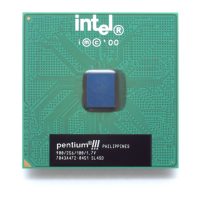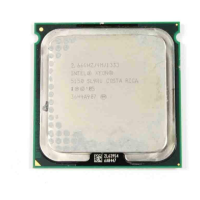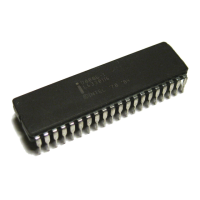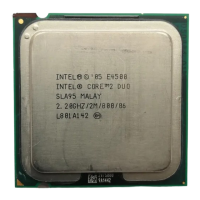Datasheet 75
Thermal Specifications and Design Considerations
5 Thermal Specifications and
Design Considerations
5.1 Processor Thermal Specifications
The Pentium 4 processor in the 775-land package requires a thermal solution to maintain
temperatures within operating limits as set forth in Section 5.1.1. Any attempt to operate the
processor outside these operating limits may result in permanent damage to the processor and
potentially other components within the system. As processor technology changes, thermal
management becomes increasingly crucial when building computer systems. Maintaining the
proper thermal environment is key to reliable, long-term system operation.
A complete thermal solution includes both component and system level thermal management
features. Component level thermal solutions can include active or passive heatsinks attached to the
processor Integrated Heat Spreader (IHS). Typical system level thermal solutions may consist of
system fans combined with ducting and venting.
For more information on designing a component level thermal solution, refer to the Intel
®
Pentium
®
4 Processor on 90 nm Process in the 775-Land Package Thermal Design Guidelines.
Note: The boxed processor will ship with a component thermal solution. Refer to Chapter 7 for details on
the boxed processor.
5.1.1 Thermal Specifications
To allow for the optimal operation and long-term reliability of Intel processor-based systems, the
system/processor thermal solution should be designed such that the processor remains within the
minimum and maximum case temperature (T
C
) specifications when operating at or below the
Thermal Design Power (TDP) value listed per frequency in Table 5-1. Thermal solutions not
designed to provide this level of thermal capability may affect the long-term reliability of the
processor and system. For more details on thermal solution design, refer to the appropriate
processor thermal design guidelines.
The Pentium 4 processor in the 775-land package introduces a new methodology for managing
processor temperatures which is intended to support acoustic noise reduction through fan speed
control. Selection of the appropriate fan speed will be based on the temperature reported by the
processor’s thermal diode. If the diode temperature is greater than or equal to T
CONTROL
, the
processor case temperature must remain at or below the temperature as specified by the thermal
profile. If the diode temperature is less than T
CONTROL
then the case temperature is permitted to
exceed the thermal profile, but the diode temperature must remain at or below T
CONTROL
. Systems
that implement fan speed control must be designed to take these conditions into account. Systems
that do not alter the fan speed only need to guarantee the case temperature meets the thermal profile
specifications.
To determine a processor's case temperature specification based on the thermal profile, it is
necessary to accurately measure processor power dissipation.

